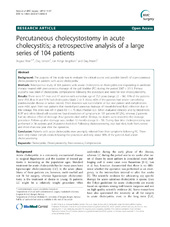| dc.description.abstract | Background: The purpose of this study was to evaluate the clinical course and possible benefit of a percutaneous cholecystostomy in patients with acute cholecystitis. Methods: Retrospective study of 104 patients with severe cholecystitis or cholecystitis not responding to antibiotic therapy treated with percutaneous drainage of the gall bladder (PC) during the period 2007 – 2013. Primary outcome was relief of cholecystitis, complications following the procedure and need for later cholecystectomy. Results: There were 57 men and 47 women with a median age of 73,5 years (range 22 – 96). 43% of the patients were ASA III or IV and 91% had cholecystitis Grade 2 or 3. About 60% of the patients had severe comorbidity (cardiovascular disease or active cancer). Drain insertion was successful in all but one patient and complications were mild, apart from two patients that needed percutaneous drainage of intraabdominal fluid collection due to bile leakage. The drain was left in place for 1 – 75 days (median 6,5). When evaluated clinically and by blood tests (CRP and white blood cell counts) we found resolution of symptoms in 101 patients (97,2%), whereas 2 patients had no obvious effect of drainage. Four patients died within 30 days, no deaths were related to the drainage procedure. Follow-up after drainage was median 12 months (range 0 – 78). During that time cholecystectomy was performed in 30 patients and 24 patients had died. Following cholecystectomy, two had died, both from cancer and more than one year after the operation. Conclusion: Patients with acute cholecystitis were promptly relieved from their symptoms following PC. There were only minor complications following the procedure and only about 30% of the patients had a later cholecystectomy. | en_US |

